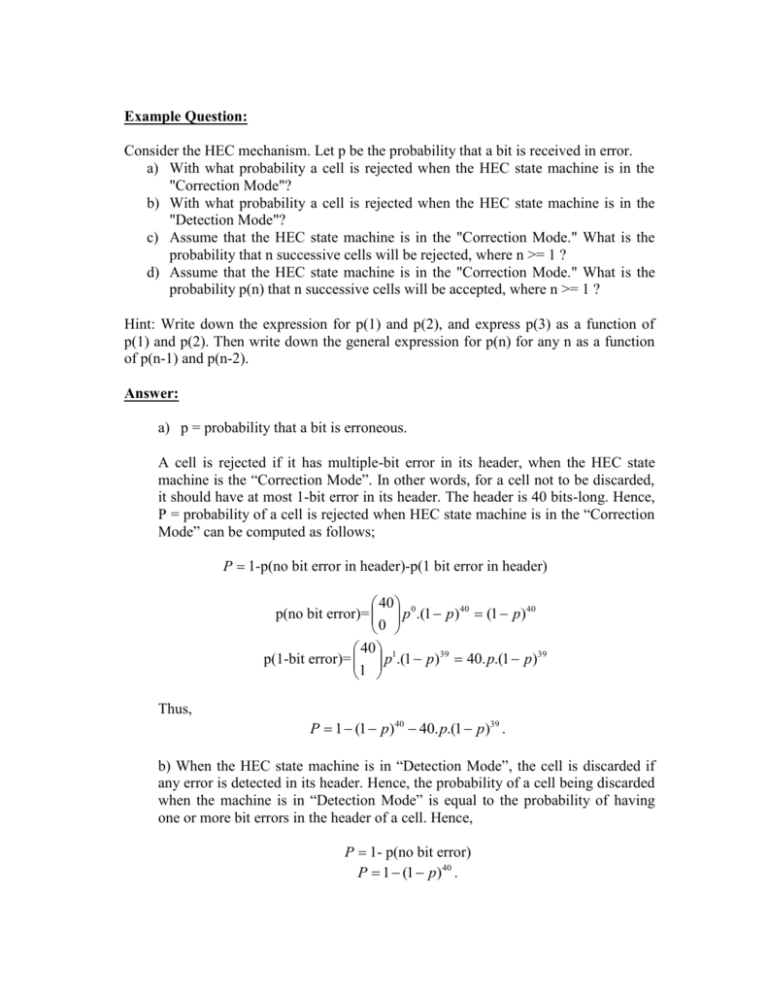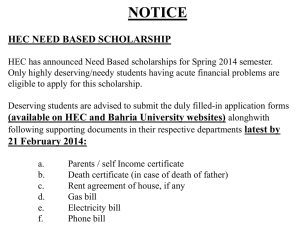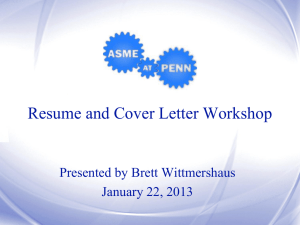example
advertisement

Example Question: Consider the HEC mechanism. Let p be the probability that a bit is received in error. a) With what probability a cell is rejected when the HEC state machine is in the "Correction Mode"? b) With what probability a cell is rejected when the HEC state machine is in the "Detection Mode"? c) Assume that the HEC state machine is in the "Correction Mode." What is the probability that n successive cells will be rejected, where n >= 1 ? d) Assume that the HEC state machine is in the "Correction Mode." What is the probability p(n) that n successive cells will be accepted, where n >= 1 ? Hint: Write down the expression for p(1) and p(2), and express p(3) as a function of p(1) and p(2). Then write down the general expression for p(n) for any n as a function of p(n-1) and p(n-2). Answer: a) p = probability that a bit is erroneous. A cell is rejected if it has multiple-bit error in its header, when the HEC state machine is the “Correction Mode”. In other words, for a cell not to be discarded, it should have at most 1-bit error in its header. The header is 40 bits-long. Hence, P = probability of a cell is rejected when HEC state machine is in the “Correction Mode” can be computed as follows; P 1-p(no bit error in header)-p(1 bit error in header) 40 p(no bit error)= p 0 .(1 p) 40 (1 p) 40 0 40 p(1-bit error)= p1.(1 p)39 40. p.(1 p)39 1 Thus, P 1 (1 p)40 40. p.(1 p)39 . b) When the HEC state machine is in “Detection Mode”, the cell is discarded if any error is detected in its header. Hence, the probability of a cell being discarded when the machine is in “Detection Mode” is equal to the probability of having one or more bit errors in the header of a cell. Hence, P 1- p(no bit error) P 1 (1 p)40 . c) The HEC state machine is in the “Correction Mode”. To reject first one of the successive n cells, the cell must have multiple-bit errors with a probability derived in part (a) as 1 (1 p)40 40. p.(1 p)39 . After this point, the machine goes into “Detection Mode”. To reject remaining n-1 successive cells, it is sufficient that each of them has at least one bit error in their headers. This probability was derived in part (b) as 1 (1 p) 40 . Hence, the probability of rejecting n successive calls starting from the “Correction Mode” is given as, P 1 (1 p)40 40. p.(1 p)39 . 1 (1 p)40 . d) The HEC state machine is in the “Correction Mode”. To accept a cell in this mode, it must have either no error or at most 1 bit error in its header. If it has 1 bit error in its header, the state machine goes to “Detection mode”, which means next cell's header should be error-free to keep the n successive acceptance sequence. n 1 Let m and s be the probabilities of the two cases that a cell can be accepted when the machine is in “Correction Mode”, where m=p(no error in cell header)= (1 p) 40 s=p(1-bit error in cell header)= 40. p.(1 p)39 , and p(n)=p(n successive cells are accepted). Thus, the first of these probabilities is p(1) m s . Accepting 2 consecutive cells can occur only under two circumstances: The second cell is error-free (with probability m) AND the first cell had either 1-bit error or no errors (with probability (m + s)). OR The second cell has 1-bit error (with probability s) AND the first cell had no error (with probability m). Hence, p(2) (m s) p(1) ms Accepting 3 consecutive cells can occur only under two circumstances: The third cell is error-free (with probability m) AND the first two consecutive cells were accepted (with probability p(2)). OR The third cell has 1-bit error (with probability s) AND the previous cell has no errors (with probability m) AND first cell was accepted (with probability p(1)). Hence, p(3) mp(2) msp(1) Therefore, with the same reasoning, accepting n (n>2) consecutive cells can occur only under two circumstances: The last cell is error-free (with probability m) AND the first (n-1) consecutive cells were accepted (with probability p(n-1)). OR The last cell has 1-bit error (with probability s) AND the previous cell has no errors (with probability m) AND the first (n-2) cells were accepted (with probability p(n-2)). Hence, p(n) mp(n 1) msp(n 2) p(n) (1 p) 40 p(n 1) (1 p) 40 40. p.(1 p)39 p(n 2) p(n) (1 p) 40 p(n 1) 40. p.(1 p)39 p(n 2)









